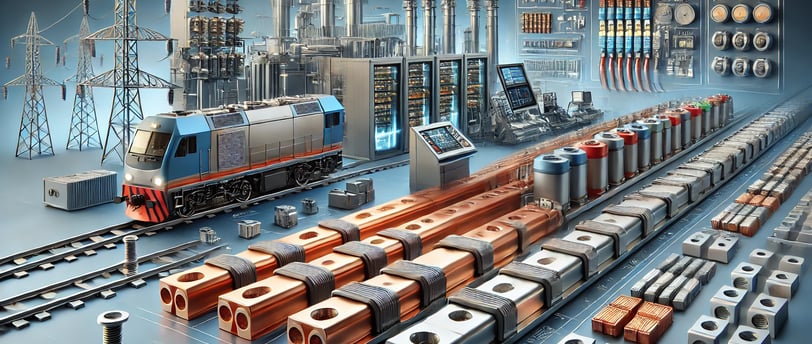The Role of Busbars in Modern Power Distribution
7/14/20243 min read


The Role of Busbars in Modern Power Distribution
Busbars play a pivotal role in the electrical infrastructure of our world, ensuring the efficient and reliable distribution of electrical power across various sectors. From industrial facilities to renewable energy systems, data centers to electric vehicles, busbars are integral to modern electrical engineering. This article explores the importance of busbars and their impact on contemporary power distribution systems.
1. Fundamentals of Busbar Technology
Definition and Function: Busbars are metallic strips or bars, typically made of copper, aluminum, or composite materials, that conduct electricity within a power distribution system. They serve as central hubs, distributing electrical power from a single source to multiple circuits, ensuring a low-impedance path for electrical current. This minimizes energy losses and enhances system efficiency.
Material Selection: The choice of material for busbars is critical. Copper is known for its excellent electrical conductivity and thermal performance, making it ideal for high-current applications. Aluminum, while having lower conductivity, is lighter and more cost-effective, making it suitable for applications where weight is a concern. Composite materials are also emerging, offering a balance of strength, weight, and thermal properties (Compound Semiconductor News) (Electronic Power Design).
2. Applications Across Industries
Industrial Applications: In industrial settings, busbars are used in switchgear, motor control centers, and distribution panels. They provide a robust solution for managing high currents and distributing power to heavy machinery and production lines. The modular nature of busbars allows for easy expansion and reconfiguration, accommodating changes in industrial operations (Compound Semiconductor News).
Data Centers: Data centers require reliable and efficient power distribution to ensure continuous operation of servers and networking equipment. Busbars offer a flexible and scalable solution, enabling quick additions or modifications to the power infrastructure without significant downtime. Their ability to handle high current loads and provide stable connections makes them ideal for such high-demand environments (Compound Semiconductor News) (Electronic Power Design).
Renewable Energy Systems: Busbars are crucial in renewable energy installations, such as solar and wind farms. They connect multiple photovoltaic (PV) panels or wind turbines to the power grid, managing the high currents generated by these systems. Innovations in busbar technology, such as laminated busbars, enhance the efficiency of energy conversion and distribution, reducing losses and improving overall system performance (Compound Semiconductor News)(SciTechnol).
Electric Vehicles (EVs): The rise of electric vehicles has increased the demand for efficient power distribution systems within vehicles and charging infrastructure. Busbars are used in EV batteries, power electronics, and charging stations to manage high power densities and ensure reliable energy transfer. Smart busbars with integrated monitoring systems are becoming essential for maintaining the safety and efficiency of EV power systems (Ennovi) (Electronic Power Design).
3. Innovations Driving the Future
Smart Busbars: Integration of sensors and IoT technology into busbars has led to the development of smart busbars. These advanced systems monitor electrical parameters in real-time, allowing for proactive maintenance and early detection of issues. Smart busbars enhance system reliability and safety, making them indispensable in critical applications (Ennovi) (SciTechnol).
High-Density and Laminated Designs: Innovations in design, such as high-density and laminated busbars, are reducing the size and weight of power distribution systems while increasing their capacity. These designs are particularly beneficial in applications where space is limited, such as in data centers and aerospace. Laminated busbars also reduce electrical noise and improve thermal management, further enhancing system efficiency (Compound Semiconductor News)(SciTechnol).
Eco-Friendly Materials: As sustainability becomes a priority, the development of busbars using eco-friendly materials is gaining traction. Recycled metals and biodegradable insulation materials are being used to reduce the environmental impact of busbar production and disposal. These sustainable practices align with global efforts to reduce carbon footprints and promote green technologies (Ennovi) (Electronic Power Design).
Conclusion
Busbars are integral to the efficient and reliable distribution of electrical power in modern infrastructure. Their versatility and adaptability make them suitable for a wide range of applications, from industrial facilities to renewable energy systems and electric vehicles. Innovations in materials, design, and smart technologies are driving the future of busbar technology, enhancing performance and sustainability. As the demand for efficient power distribution continues to grow, busbars will remain a cornerstone of electrical engineering, ensuring that power systems are robust, reliable, and ready to meet the challenges of the future.
References
Understanding Busbars: Types, Applications, and Advantages - CSFusion.org (Compound Semiconductor News).
Enabling Smaller, Smarter Busbar Designs that Support Higher Power Densities - Ennovi (Ennovi).
Advanced Busbar Systems for Electrical Engineer Contractors - Electronic Power Design (Electronic Power Design).
Efficiency through Busbars: Innovations in Power Distribution - SciTechnol.com (SciTechnol).


